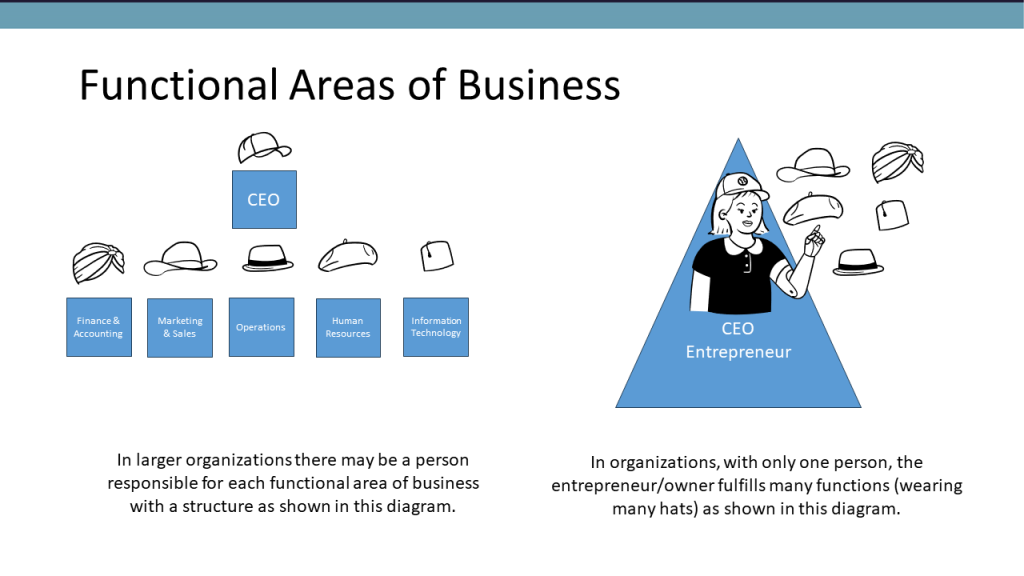Functional Areas of Business
The activities needed to operate a business can be divided into a number of functional areas. Examples include management, operations, marketing, accounting, finance information technology, and human resources. Let’s briefly explore each of these areas.
Management
Managers are responsible for the work performance of other people. Management involves planning for, organizing, leading, and controlling a company’s resources so that it can achieve its goals. Managers plan by setting goals and developing strategies for achieving them. They organize activities and resources to ensure that company goals are met and staff the organization with qualified employees and managers lead them to accomplish organizational goals. Finally, managers design controls for assessing the success of plans and decisions and take corrective action when needed.
Operations
All companies must convert resources (labour, materials, money, information, and so forth) into goods or services. Some companies, such as Apple, convert resources into tangible products—Macs, iPhones, etc. Others, such as hospitals, convert resources into intangible products — e.g., health care. The person who designs and oversees the transformation of resources into goods or services is called an operations manager. This individual is also responsible for ensuring that products are of high quality. In many organizations, operations management includes managing the supply chain which controls the delivery of raw materials and the distribution of finished goods.
Marketing
Marketing consists of everything that a company does to identify customers’ needs (i.e. market research) and design products to meet those needs. Marketers develop the benefits and features of products, including price and quality. They also decide on the best method of delivering products and the best means of promoting them to attract and keep customers. They manage relationships with customers and make them aware of the organization’s desire and ability to satisfy their needs.
Accounting
Managers need accurate, relevant and timely financial information, which is provided by accountants. Accountants measure, summarize, and communicate financial and managerial information and advise other managers on financial matters. There are two fields of accounting. Financial accountants prepare financial statements to help users, both inside and outside the organization, assess the financial strength of the company. Managerial accountants prepare information, such as reports on the cost of materials used in the production process, for internal use only.
Finance
Finance involves planning for, obtaining, and managing a company’s funds. Financial managers address such questions as the following: How much money does the company need? How and where will it get the necessary money? How and when will it pay the money back? What investments should be made in plant and equipment? How much should be spent on research and development? Good financial management is particularly important when a company is first formed because new business owners usually need to borrow money to get started.
Information Technology
Information is one of the critical assets of most businesses. Businesses such as Facebook are entirely information based businesses. Information technology (IT) managers are concerned with building computer and network infrastructure, implementing security protocols, and developing user interfaces and apps for customers. Usually, there is a high level of integration between the businesses website or application and other departments within the business, such as finance, marketing and operations. Often, businesses must develop interfaces to send and receive information from other companies, including suppliers, logistics and shipping suppliers.
Human Resources
HR managers are responsible for ensuring that the organization has all of the skills and capabilities necessary to run the business. HR managers develop staffing plans, recruit and select new employees, monitor the performance management process, and develop succession plans for advancement and replacement. They develop standards for compensation and benefits and assist managers with staff issues.
The image below shows two ways that the functional areas of business are applied. Typically, smaller (or even large) organizations assign individuals or teams to perform each of the functional roles. For example a marketing manager concerns herself the most with marketing matters, etc. In many small organizations where the owner is the CEO and fulfills all the functions its a one person show. Consider the roles like hats to be worn. In a one person organization, the CEO/ entrepreneur wears all the hats!

When we look at the functional area of business, we are organizing the work in terms of the type of work. The most common function areas are marketing, information technology, human resources, finance, operations, and accounting.
These are functions that important are for the business to do. In small businesses, the owner may do the finance, accounting, and human resource functions along with overseeing the operations. In large businesses, these functions are often broken down into departments that have large groups of people working within each function.

